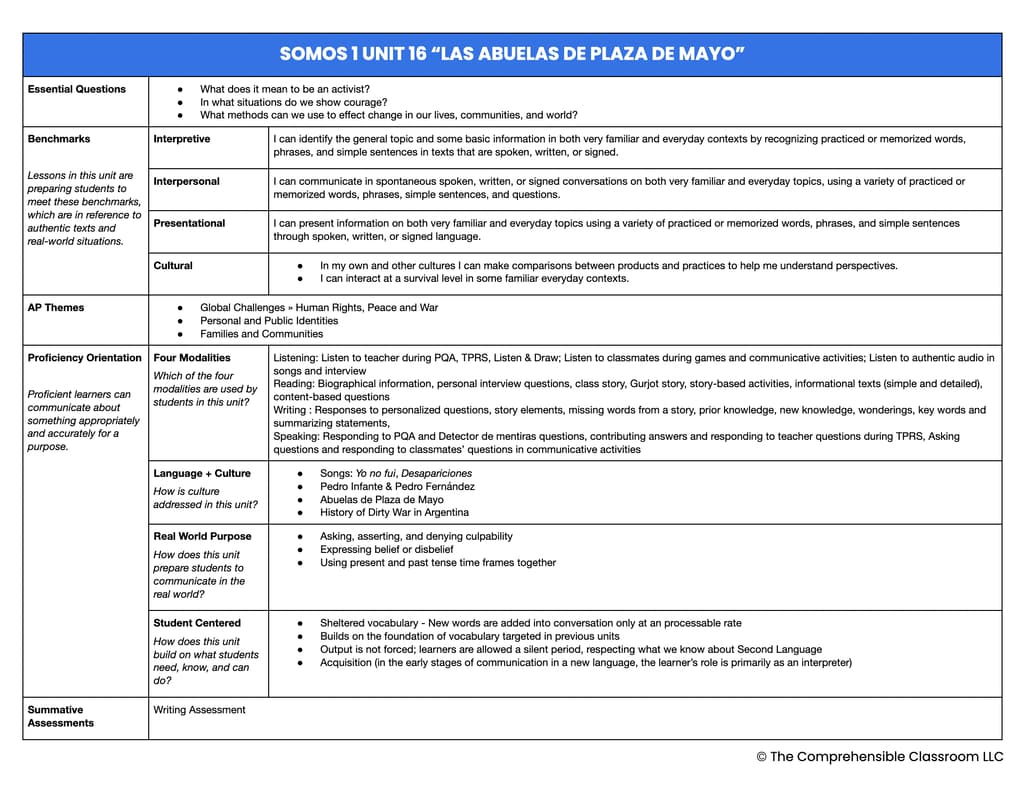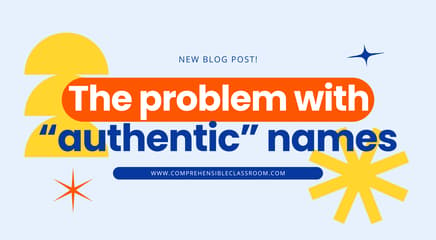As language teachers, our goal for our students is to be more proficient in the target language when they complete our course than when they began. We probably have other goals for our students (being more kind, more empathetic, more responsible, more culturally aware), but all of these objectives fit into the overarching mission of PROFICIENCY.
But what is proficiency? And how do orient our instruction toward it?
My friends: run to the bathroom, refill your coffee cup, plug in your computer, and settle in for the beginner's guide to Proficiency Oriented Language Instruction.
WHAT IS PROFICIENCY?
According to the Center on Advanced Research for Language Acquisition (CARLA), there are three components to proficiency:
- CONTENT: the topic(s) of communication
- FUNCTION: the task to be completed; the purpose for communicating
- ACCURACY: correctness or appropriateness of the language for the context
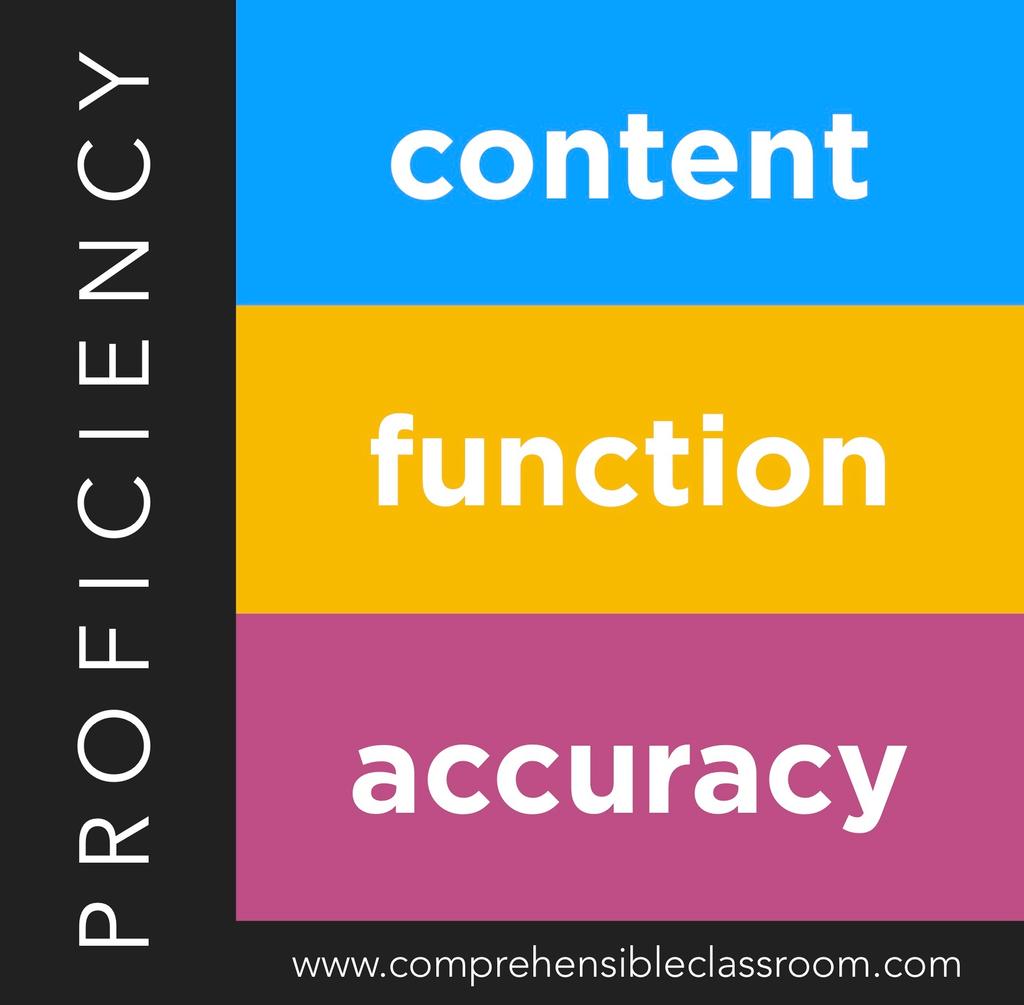
In other words (aka the Martina Bex quick definition):
Proficient learners can communicate about something appropriately and accurately for a purpose.
Write this on your doorposts. Bind this to your foreheads. Teach it to your students. Talk about it as you walk down the halls and as you sit at your desk and stand at the door greeting your precious learners. THIS IS THE GOAL!!! This is your vision for your students. What we want for each one of the humans that we get to spend time with in class is for them to be able to communicate about something ever more appropriately, ever more accurately, for a purpose.
Isn’t our job cool?
...but how do we get there?
WHAT DOES PROFICIENCY ORIENTED LANGUAGE INSTRUCTION LOOK LIKE?
On its website, CARLA describes these characteristics for proficiency-oriented language instruction:
Proficiency-oriented language instruction is a general framework for organizing instruction, curriculum, and assessment, rather than a method or a theory. Within this framework, language learners practice the four modalities (listening, speaking, reading, and writing) in order to communicate meaningfully, effectively, and creatively in their target language for real-life purposes. A proficiency orientation promotes intercultural communication by exploring the mosaic of language and culture, so that students can communicate appropriately and accurately in authentic contexts in the foreign language. Proficiency-based instruction is student-centered and builds upon what students need, already know, and can do, and it respects diverse learning styles, while encouraging the development of a wide range of skills and learning strategies.
Whew! That is a meaty definition. After reading it a few times, here are the four key elements that I extracted:
» Four Modalities
» Language and Culture
» Real World Preparation
» Student Centered
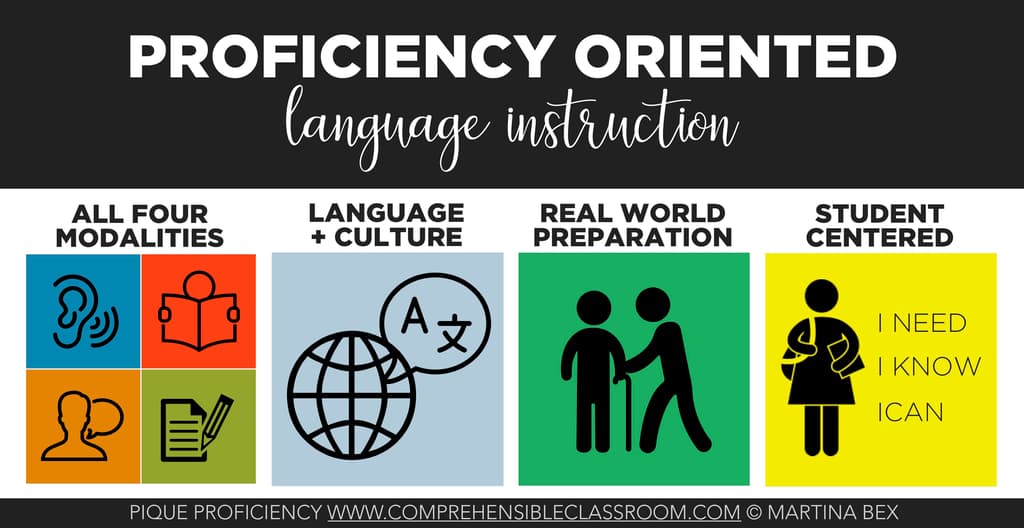
Let’s dig in:
FOUR MODALITIES
Proficiency oriented language classes should allow opportunities for students to listen, read, write, and speak (in) the target language. These opportunities should allow students to function at or slightly above their current level of proficiency in each modality. It behooves us to familiarize ourselves with ACTFL’s Proficiency Guidelines (or the equivalent from a different professional organization), as well as the Performance Descriptors (which essentially translate the Proficiency Guidelines--which describe performance in the real world--into the classroom setting). Once we know what performance at each sub-level of proficiency looks like, we can adjust expectations for our students' communication accordingly.
Let us not misinterpret the need for all modalities in a proficiency-oriented language instruction as the need for the the equal presence of all modalities. At AFLA 2016, Bill VanPatten said:
“There are two sides to communication - interpretation and expression. A learner's job in the early stages is largely interpretation.”
When we understand how language is acquired (by attending to written and spoken messages that we understand (COMPREHENSIBLE INPUT)), we can confidently dedicate the bulk of time spent in class to interpretive activities such as
- TPRS (Teaching Proficiency through Reading and Storytelling)
- MovieTalk
- Embedded Reading
- Card Talk
- Storytelling
- PQA (Personalized Questions and Answers)
- Choral reading
- TPR (Total Physical Response)
- Reading novels
- Playing and narrating games (Mafia, Unfair Game, Where is the Dog, etc.)
- Special Person interviews
How might the four modalities manifest themselves in a beginning comprehension based course?
LISTENING: Listening to the teacher tell a story, Listening to questions asked by the teacher, Listening to the teacher describe a film
READING: Choral reading with the class, Reading stories that have been told/asked in class, Embedded reading, Reading storyboards
WRITING: Filling in missing words in CLOZE passages, Free Writes, Completing personalized sentence frames
SPEAKING: Responding to simple questions from the teacher (yes/no, either/or, etc.), Re-telling class stories, Reacting with rejoinders
As students continue in language courses, student output and ability to interpret input will progress along the proficiency scale, becoming ever more advanced. But even as students' expressive proficiency increases, the role of input never diminishes. Input must always play a critical role in the language learner’s experience.
What about grammar?
Notice that grammar is not mentioned even once in CARLA’s description of the characteristics for Proficiency Oriented Language Instruction—and yet ACCURACY is one of the three components of Proficiency (along with Content and Function).
Our students’ productive accuracy increases as their mental representation of language grows and is strengthened. Their mental representation of language—which is how language is stored in our brains—is strengthened and expands through input...comprehensible input.
As language teachers, we must put IN what we want to come OUT. Because we want our students to be able to communicate about something appropriately and accurately for a purpose, we must communicate with them in class--appropriately and accurately for a purpose.
Proficiency Oriented Language Instruction is not
- grammar drills
- vocabulary games
- memorizing dialogues
- working on cultural projects
Please don’t misinterpret this as me saying that if you do any of those things, you are not doing right by your students. There are reasons for doing each of those activities—and you, as an intelligent professional, might choose to use those activities in your class. No judgement! We are each responsible for understanding how language is acquired and then making the choices that are best for our unique teaching situation (self, students, school).
LANGUAGE AND CULTURE
In 2014, ACTFL published a Global Competence Position Statement, and it states that “The ability to communicate with respect and cultural understanding in more than one language is an essential element of global competence”. Global competence allows learners to communicate successfully with speakers of another language; with humans that have different cultures than the learner’s own. As we orient our instruction toward linguistic proficiency, we must also keep cultural proficiency in our sights. And where our students’ cultural proficiency falls short, their global competence is the net that will save them from intercultural failure.
When looking to build Global Competence in our students, consider this:
- We must bring the target culture into our classes.
- Presenting facts is not enough. As we expose learners to products, practices, and perspectives from other cultures (including those of the target culture(s)), we can use the recommendations taken from ACTFL’s Global Competence Position Statement:
“Recognize the multiplicity of factors that influence who people are and how they communicate. Investigate and explain cultural differences as well as similarities, looking beneath the surface of stereotypes. Examine events through the lens of media from different countries and cultures. Collaborate to share ideas, discuss topics of common interest, and solve mutual problems. Reflect on one’s personal experiences across cultures to evaluate personal feelings, thoughts, perceptions, and reactions.”
Look for opportunities to dialogue with your students about the products, practices, and perspectives that are exposed through the culture that you bring into class.
REAL WORLD PREPARATION
We are not preparing students to speak the target language to other language learners and teachers within the four walls of a classroom. We are preparing students to communicate in the target language in the real world—with real humans.
I strongly believe that this does not mean that our classrooms should be replicas of the real world. I do not believe that it means that we must use exclusively authentic resources. I no longer believe that it means that we must use 100 percent native-like target language and demand the same from our students (although I did believe this when I started teaching!).
To prepare our students to communicate in the real world with real speakers of the target language, we must equip our students with language that will be useful to them in the world outside our classroom walls, and we must structure our classes such that students can actually acquire that useful language.
Ahhh…language acquisition:
We acquire language when we understand messages; when we understand what people tell us and when we understand what we read. —Stephen Krashen
That’s it. Our only job is to speak with our students in such a way that they understand us and to provide them with texts to read that they can understand.
As far as useful language goes—well, some teachers might find it helpful to strategically plan exposure to high frequency verbs, such as Terry Waltz’s “Super Seven” or Mike Peto’s expanded “Sweet Sixteen”. But truly, there is no need to intentionally target high frequency verbs. When you are focused on communicating in meaningful ways with your students, you will naturally use those high frequency verbs—the very same ones that will be most useful to your students when it comes time to communicate in the real world.
I also want to note very quickly that I am an advocate for the scaffolded use of authentic resources in language classes. I do not believe that it is the best use of our precious class time to help students practice the skill of interpreting authentic resources. I do agree with the research that demonstrates that authentic resources are valuable for a variety of reasons, and so I look for opportunities to include high-interest #authres in my curriculum that can generate comprehensible input.
My quick guide to Real World Preparation, then, is to communicate meaningfully and naturally in class using language that will be useful in the real world.
STUDENT CENTERED
CARLA describes student-centered instruction as instruction that builds upon “what students need, already know, and can do”.
Different than a common (mis)understanding of student centered; CARLA’s description does not dictate roles or activities in a lesson. It does not say that students should be the doers and teachers should be the ‘guides on the side’. CARLA’s definition describes the what of a lesson. The factor that makes a lesson student centered is the CONTENT of the lesson, perhaps even more so than the method of delivery.

In comprehension based courses, this has always been the goal. We may plan out our weeks, our marking periods, our years—but at the center of our plans lie student interest and ability. Whether we are Card Talking, TPRS-ing, PQA-ing, GSSR-ing, or OWI-ing, the students drive the content. We do our utmost to become one with our students’ comprehension, employing a myriad of tools to ensure that we are carefully laying bricks on the foundation of their linguistic ability, not skipping layers or leaving holes. We celebrate what they can do, and we gently lead them on into new territory.
Students are the heart of comprehension based teaching, and it is so refreshing to see that CARLA’s definition of student-centered supports that!
MANOS A LA OBRA
Let’s apply CARLA’s characteristics for Proficiency Oriented Language Instruction to a few activities to see how they measure up:
World Cup 2018 Unfair Game (for Level 1)
Teacher prepares 25 questions in the target language about the 2018 World Cup and provides four possible answers, also in the TL. The class is divided into two teams and plays The Unfair Game: students that followed the World Cup respond based on background knowledge, and students that didn’t are making their best guess.
- Content: The 2018 World Cup
- Function: I can participate knowledgeably in a conversation about soccer
- Accuracy: The teacher attends to accuracy by ensuring that students comprehend the lesson, applying the comprehension supports outlined in this post.

Four Modalities
- Listening: students listen to the teacher read the questions and answers, clarify meaning, personalize
- Reading: students read the questions and answers
- Writing: N/A
- Speaking: students respond with single word answers to the teacher’s questions
Language and Culture
How to say country names in the TL, soccer teams from the TL
Real World Preparation
Describing nationality, interpreting and expressing numbers, communicating about sports (team, wins, loses, scores, game, goal, etc.)
Student Centered
No prior knowledge of soccer or The World Cup is required; Language is simple and repetitive across questions; students can participate actively with one word responses
Possible extensions:
- Read about the rules of soccer, soccer fandom, soccer teams, soccer players in the target language.
- Interpret infographs in the target language about the World Cup
- Watch highlights with narration (à la MovieTalk) from the World Cup
- Listen to/interpret World Cup theme songs from 2018 or past years
- Write a summary of the 2018 World Cup
La chanson du caca/Motocrotte (for French Level 1)
Students sing La chanson du caca and then learn about Motocrotte.
- Content: Motocrotte
- Function: I can express whether something is typical or not
- Accuracy: The teacher attends to accuracy by ensuring that students comprehend the lesson, applying the comprehension supports outlined in this post.
Four Modalities
- Listening: Students listen to the song & listen to teacher questions
- Reading: Students read song chorus, song lyrics, opinion statements involving the song lyrics, and summary of Motocrotte
- Writing: Students write ‘C’est normal’ or ‘C’est dégoûtant’ on whiteboards in response to question prompts
- Speaking: Students sing along with the song, provide one-word answers to the teacher’s questions
Language and Culture
Learning about Motocrotte, a past solution for the dog poop problem on the streets of France
Real World Preparation
Saying whether something is normal or gross, using the verb ‘faire’ (to do/make)
Student Centered
Everyone poops! (on fait caca !), simple, repetitive lyrics, students can express opinions using sentence skeletons
Possible extensions:
- Compare regulations in France regarding dog poop clean up to regulations in our community
- Discuss problems in our community and possible solutions
- Explore ways that other communities and countries have tackled the same problem
- Consider how France is handling the problem now (did Motocrotte work or not?)
- Learn about Madame Courtcaca (or La Correcaca)
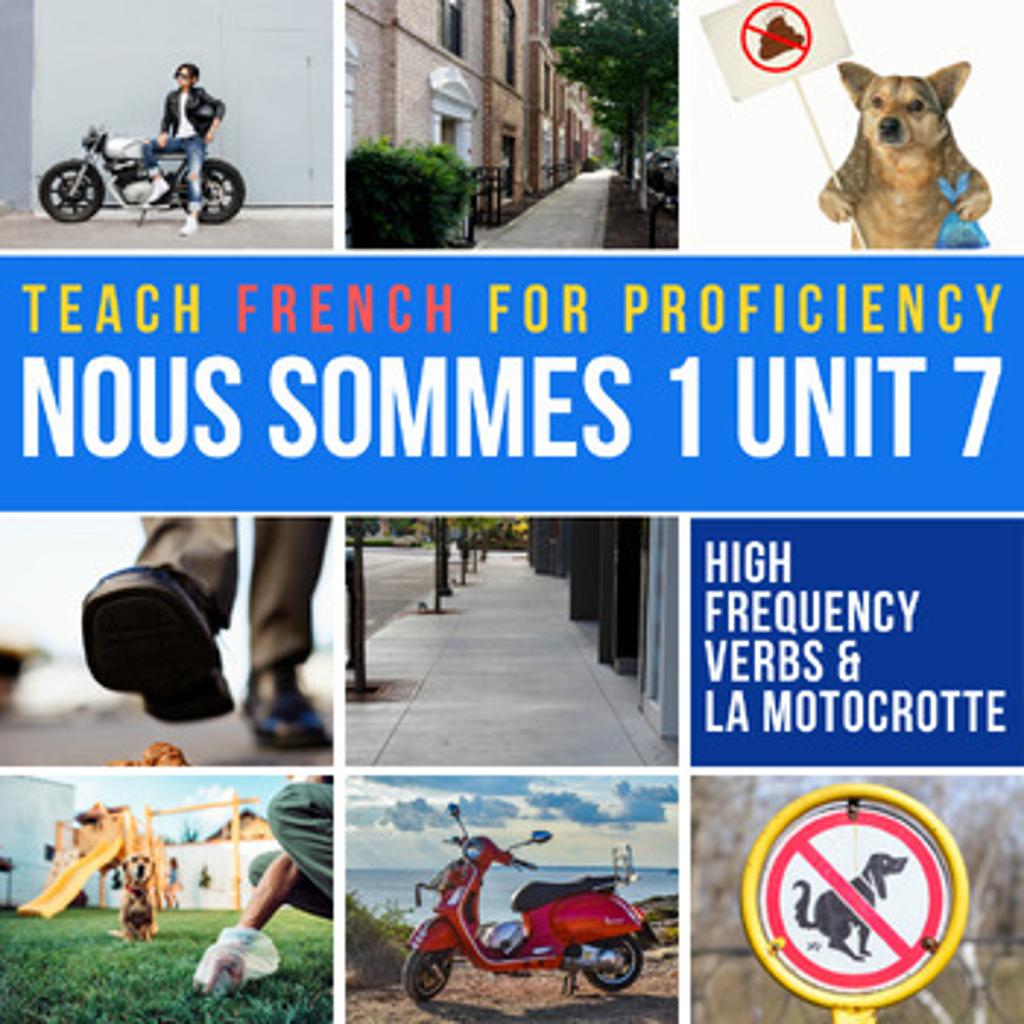
Wildebeest MovieTalk (for Level 1)
Teacher shows Wildebeest to students with MovieTalk technique, applying the skills and steps of TPRS to the traditional MovieTalk activity. As the teacher narrates the dialogue, s/he uses the sentence frame “I think that [it is a log]” and “I don’t think that [it is a log]”, and asking questions to the class, “Does [wildebeest 1] agree with [wildebeest 2]?”.
- Content: Wildebeest
- Function: I can express disagreement.
- Accuracy: The teacher attends to accuracy by ensuring that students comprehend the lesson, applying the comprehension supports outlined in this post.
Four Modalities
- Listening: Students listen to the teacher describing the short film
- Reading: Students read a summary of the film after the MovieTalk is complete
- Writing: Students copy a sentence from the summary to play Write, Draw, Pass
- Speaking: Students respond with 1-2 word answers to the teacher’s questions, students retell the story using the Blind Retell format after reading the summary
Language and Culture N/A
Real World Preparation
Expressing your thoughts, Expressing agreement/disagreement, Reporting what someone else says and thinks, Expressing identity
Student Centered
Simple, repetitive plot; Humorous film; Simple language; Builds off ‘Dice’ story script
Possible extensions:
- Watch videos/learn about predators and prey in areas in which the target language is spoken
- Students write an alternate ending to the story
- Watch real life videos of Wildebeest and crocodiles
- Watch video of woman threatening a crocodile with a Chancla
By reflecting on the three components of proficiency (Content, Function, and Accuracy), and considering the characteristics of proficiency oriented instruction, my hope is that you will be able to plan your best school year yet, confident that your courses are comprehension based and oriented toward proficiency.
I have begun the process of detailing the elements of proficiency oriented instruction present in each of the units from my Somos Level 1 and Somos Level 2 curricula. I will be adding this element to the each Unit Overview. Here is the completed overview for Somos 1 Unit 16:
And now...your turn!
Would you describe an activity that you have planned for this year? Explain which characteristics of proficiency oriented instruction it embodies, and offer ideas for extensions to fill in the gaps!


